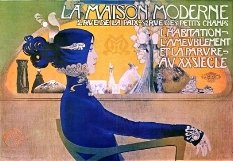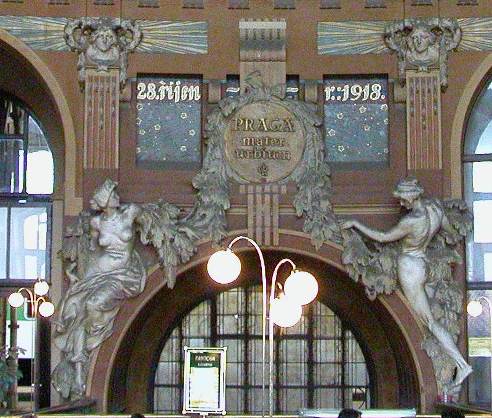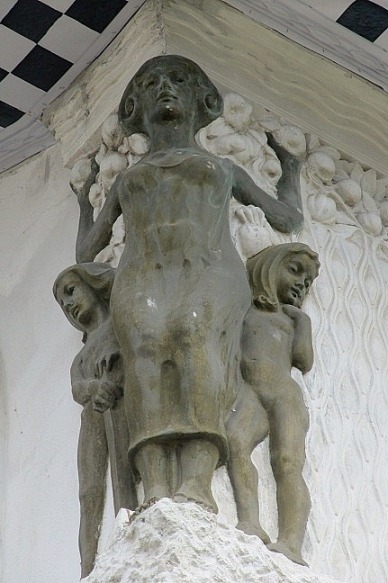Art Nouveau Architecture
Art Nouveau Architecture - Otto Wagner and the Vienna Secession
Art Nouveau architecture was the application of the exciting "New Art" to architecture. How it affected architecture varied from country-to-country.

In some cases Art Nouveau architecture was simply the use of Art Nouveau decoration on forms that varied little from the classical. An example of this is Otto Wagner, a Viennese architect. His decoration is an exuberant use of the style, but underneath you have a building that would comfortably fit into a traditional neighborhood. Below I have the example of his Majolikahaus. It is a fairly simple apartment building but the decorative tile and the iron railings are pure Art Nouveau. His Stadtbahn subway entrance strays a little further from the classical field, but once again it is in the decoration where he goes wild.
His students were not so tied to the classical forms and explored applying this “New Art” to the structures themselves. How they struck out from the classical and gothic past varied, but in some of their buildings we see the first hints of what would soon be called the “Modern” style.
Now sinuous curves do not easily apply to structures. When you strike out from the past there are a great number of directions you can go. Where most architects went did not particularly embody the basic characteristics of Art Nouveau. In some cases, while they were experimenting with new designs they were also experimenting with new materials. The new materials opened up possibilities not previously allowed to architects confined to wood and stone.
A case in point is the Stoclet Palace. This house was built by Josef Hoffman, a pupil of Otto Wagner, for a Brussels banker, Adolphe Stoclet. At least on the outside its Art Nouveau influences are minimal. It has decorative tile at the corners, and it has statues and carvings about the central tower. The iron work bears Art Nouveau inspired patterns. Otherwise you have a building that bears a strong resemblance to the minimalist designs that arose a couple of decades later and continued throughout the 20th century.

Art Nouveau Architecture - Odon Lechner
If Art Nouveau led some architects to venture into modernism, it led others to explore their roots. Such was the case with Odon Lechner, a Hungarian Architect. His reaction against the prevailing architectural styles was to look East, to create a Hungarian architecture. I give an example below, the Geological Museum in Budapest, as typical of his work. The influences of Art Nouveau are not readily apparent on his exteriors. The curves formed by the brick against the stucco could just as easily have come out of the Rococo movement two hundred years prior.
Lechner was not alone in trying to meld Art Nouveau with a nationalist architecture. Art Nouveau did not exist in a vacuum. There were other ideas floating around and nationalism was one of them. Using something international like Art Nouveau to create a distinctly regional architecture is a pattern we see repeated across Europe and even in the United States.
Art Nouveau Architecture - Railway Art
The years of Art Nouveau happily coincided with a period of investment in subways and railroads and such new, modern conveniences suggested that new ideas be used in the construction of their facilities. Remember Otto Wagners Karlsplatz Stadtbahn? Immediately below is a picture of a subway entrance designed by Henri Guimard in Paris.

While in Russia Stanislaw Brzozowski designed the first Railway Station in Saint Petersburg. The structure itself was a mix of styles, but the interior design was heavily Art Nouveau. Here is an amazing interior wall. Wood arches flow into a complicated arrangement of curves. Here is a taste of what is possible when Art Nouveau is applied to building structures.
Art Nouveau Architecture - Josef Fanta
Over in Prague we have an opera house, the Prague Municipal House, designed by Josef Fanta. The exterior is interesting, but again it makes no great break from tradition.
Instead it is the detailing that shows the Art Nouveau influence. Here is an interior view showing a sculpture adorning an arch. Above the sculpture are some busts. All the human figures are portrayed realistically, more so than is ordinary for this style, but the sinuous swage of leaves and the sunburst background to the busts stamp this as Art Nouveau.

Art Nouveau Architecture - Schiavon and Barbison
On the other side of the world, in Valpraiso, Chile, a couple of Italian émigrés (Renato Schiavon and Arnaldo Barbison) from what was then the Austro-Hungarian Empire built an interesting house for a nitrate magnate, Palace Barburizza. Again it is difficult to grasp the Art Nouveau influence until you see the detailing.

Art Nouveau Architecture - Charles Rennie MacKintosh

As I close out this article I will conclude by saying that most of what I showed you has been the style applied as decoration. In my next article I will cover Art Nouveau when it went deep into the heart of the building, when we look at Antoni Gaudi and Victor Horta.
To Top of Page - Art Nouveau Architecture
To Page 2 of this Series
To Page 3 of this Series
Return to House Styles
Home - House Design
Please!
Have A Great Story About This Topic?
Do you have a great story about this? Photos of great houses? Maybe you can add to our body of knowledge about this subject, or maybe you just have questions. Either way feel free to participate in our conversation.













New! Comments
Have your say about what you just read! Leave me a comment in the box below.